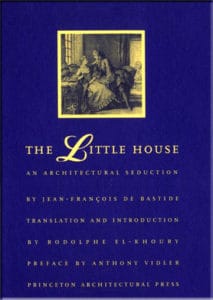 FROM THE VAULT
FROM THE VAULT
The Little House: An Architectural Seduction
By Jean-François de Bastide (Translated by Rodolphe el-Khoury), Preface by Anthony Vidler
Review by Dr. Mark David Major, AICP, CNU-A, The Outlaw Urbanist contributor
Though based on a 19th century publication, The Little House: An Architectural Seduction is, in fact, an 18th century French text, Le Petite Maison by Jean-François de Bastide. As Anthony Vidler points out in the preface, it is a peculiar French attempt to synthesize two disparate literary genres, which was quite common at the time (and still frequently occurs today to varying degrees, think of recent attempts combining juvenile romance with erotic horror in fiction titles such as Stephanie Meyer’s Twilight series, John Ajvide Lindqvist’s Let the Right One In, or Isaac Marion’s Warm Bodies). In the case of The Little House, it is the genres of the erotic romance and architectural treatise, which are synthesized by Bastide. The architectural treatise portion is beautifully composed of meticulous drawings of plans, elevations, and interior design details of the Marquis de Tremicour’s petite maison, which is visited on a dare by the virtuous Mélite. Much of the text is given over to descriptions of Tremicour’s collected objects displayed in the house. The design of the little house itself is strongly reminiscent of 16th century Palladian villas, which were also frequently used as display settings for wealthy collections of art, tapestries, inventive domestic wonders and what not rather than actual homes (the nearest American equivalent would be Thomas Jefferson’s Monticello though Jefferson’s home was also a fully-functional farmstead). The romance portion of the story details Tremicour’s attempts to use his petite maison and its collection of expensive objects to seduce Mélite.
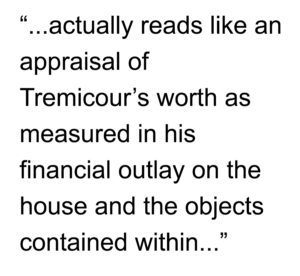 Despite Vidler’s heavily-jargon-weighed efforts to convince readers to assume a French Libertine perspective (an “alien culture”, according Vidler) in reading the text, The Little House actually reads like an appraisal of Tremicour’s worth as measured in his financial outlay on the house and the objects contained within; in this case, worth is a measure of taste that can be purchased. Vidler argues taste in the 18th century French sense is actually an aspect of touch (both literally and metaphorically, how we are physical and emotionally ‘touched’ by a person or thing). Vidler’s argument is not entirely convincing and it’s easy to wonder how the reader might react differently to the text in the absence of Vidler’s prefatory comments. Mélite’s conflicted feelings about Tremicour during her visit emerge, on one hand, from her distaste of the man and his reputation and, on the other, her appreciation of the liberating nature of his wealth in enabling him to obtain the best of things. This serves as an interesting contrast to Mélite, who is explicitly stated to have earned her taste through learning and experience (her age and wealth status are not mentioned though it’s safe to assume she is not a child and comes from a well-to-do French family). This seems to make Mélite’s dogged resistance to Tremicour’s (sometime clumsy) attempts at sexual seduction into a nature-nurture didactic whereby nature (one who is born with taste, i.e. Mélite) overcomes nurture (one who has purchased taste, i.e. Tremicour). Tremicour does have something of a nouveau riche quality about him, despite his title. However, this possible reading of the text is undercut by a revision to the ending of The Little House. According to el-Khoury’s notes, Mélite succeeded in her efforts to resist Tremicour’s attempted seduction in his petite maison and she retired to the country to recover from the ordeal in Bastide’s original ending. el-Khoury is unclear if Bastide himself changed the ending (i.e. original ending was in draft form) or if the translator has changed the ending using a 20th century perspective. Thus, The Little House ends with a threat, Mélite’s last words being “Tremicour, leave me! I do not want…”, and then brief acknowledgement of Tremicour’s success in seducing the virtuous girl. This revision is disturbing because it changes the tale from an architectural seduction into a libertine rape. The Little House thereby reasserts the purview of the masculine (of Tremicour, perhaps of the male contributors to this modern translation) over the feminine (of Mélite) in architecture and Mélite becomes, metaphorically-speaking, only another object to be collected. It is possible this review is skewed with a distinctive 21st century perspective about women but no matter how much some of us may wish to be a French Libertine, we are not.
Despite Vidler’s heavily-jargon-weighed efforts to convince readers to assume a French Libertine perspective (an “alien culture”, according Vidler) in reading the text, The Little House actually reads like an appraisal of Tremicour’s worth as measured in his financial outlay on the house and the objects contained within; in this case, worth is a measure of taste that can be purchased. Vidler argues taste in the 18th century French sense is actually an aspect of touch (both literally and metaphorically, how we are physical and emotionally ‘touched’ by a person or thing). Vidler’s argument is not entirely convincing and it’s easy to wonder how the reader might react differently to the text in the absence of Vidler’s prefatory comments. Mélite’s conflicted feelings about Tremicour during her visit emerge, on one hand, from her distaste of the man and his reputation and, on the other, her appreciation of the liberating nature of his wealth in enabling him to obtain the best of things. This serves as an interesting contrast to Mélite, who is explicitly stated to have earned her taste through learning and experience (her age and wealth status are not mentioned though it’s safe to assume she is not a child and comes from a well-to-do French family). This seems to make Mélite’s dogged resistance to Tremicour’s (sometime clumsy) attempts at sexual seduction into a nature-nurture didactic whereby nature (one who is born with taste, i.e. Mélite) overcomes nurture (one who has purchased taste, i.e. Tremicour). Tremicour does have something of a nouveau riche quality about him, despite his title. However, this possible reading of the text is undercut by a revision to the ending of The Little House. According to el-Khoury’s notes, Mélite succeeded in her efforts to resist Tremicour’s attempted seduction in his petite maison and she retired to the country to recover from the ordeal in Bastide’s original ending. el-Khoury is unclear if Bastide himself changed the ending (i.e. original ending was in draft form) or if the translator has changed the ending using a 20th century perspective. Thus, The Little House ends with a threat, Mélite’s last words being “Tremicour, leave me! I do not want…”, and then brief acknowledgement of Tremicour’s success in seducing the virtuous girl. This revision is disturbing because it changes the tale from an architectural seduction into a libertine rape. The Little House thereby reasserts the purview of the masculine (of Tremicour, perhaps of the male contributors to this modern translation) over the feminine (of Mélite) in architecture and Mélite becomes, metaphorically-speaking, only another object to be collected. It is possible this review is skewed with a distinctive 21st century perspective about women but no matter how much some of us may wish to be a French Libertine, we are not.
 The Little House: An Architectural Seduction
The Little House: An Architectural Seduction
By Jean-François de Bastide (Translated by Rodolphe el-Khoury)
Preface by Anthony Vidler
Originally published as Le Petite Maison, 1879
Princeton Architectural Press, 1996
116 pages
Available for purchase from Amazon here.
From the Vault is a new series from the Outlaw Urbanist in which we review architectural and urban design texts, with an emphasis on the obscure and forgotten, found in the second-hand bookstore.




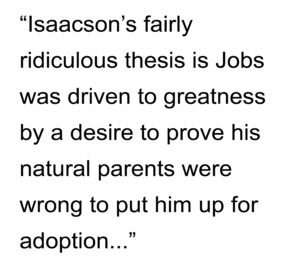 There are many useful, some wonderful insights (usually originating from Jobs himself) contained within, so it is well worth your time to read. In the end, what shines through in the book, despite its problems, is the genius and greatness of Steve Jobs.
There are many useful, some wonderful insights (usually originating from Jobs himself) contained within, so it is well worth your time to read. In the end, what shines through in the book, despite its problems, is the genius and greatness of Steve Jobs.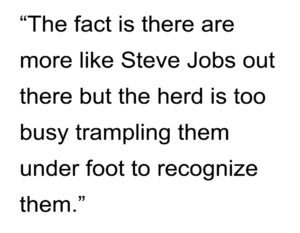 Was Steve Jobs perfect? No, he was human. Personally, I never asked for Apple products to be perfect. I only asked that Apple products be the best in the world and, usually, they were. I never asked Steve Jobs to be anything than what he was: a brilliant businessman, an insight artist, and a (sometimes) source and (often) shepherd of technological innovation. In the end, what was remarkable about Steve Jobs was not that he changed the world but he changed the world in the face of the ‘conventional wisdom’, which is often polite code for the stupidity of the consensus. Frankly, I prefer to live in Jobs’ reality. Along the way, he lived a remarkable life. Surely, that is enough. The world seems smaller without Steve Jobs in it. We have Jobs’ Apple to thank for it but it is also a testament to the legacy of Steve Jobs. He will be missed.
Was Steve Jobs perfect? No, he was human. Personally, I never asked for Apple products to be perfect. I only asked that Apple products be the best in the world and, usually, they were. I never asked Steve Jobs to be anything than what he was: a brilliant businessman, an insight artist, and a (sometimes) source and (often) shepherd of technological innovation. In the end, what was remarkable about Steve Jobs was not that he changed the world but he changed the world in the face of the ‘conventional wisdom’, which is often polite code for the stupidity of the consensus. Frankly, I prefer to live in Jobs’ reality. Along the way, he lived a remarkable life. Surely, that is enough. The world seems smaller without Steve Jobs in it. We have Jobs’ Apple to thank for it but it is also a testament to the legacy of Steve Jobs. He will be missed.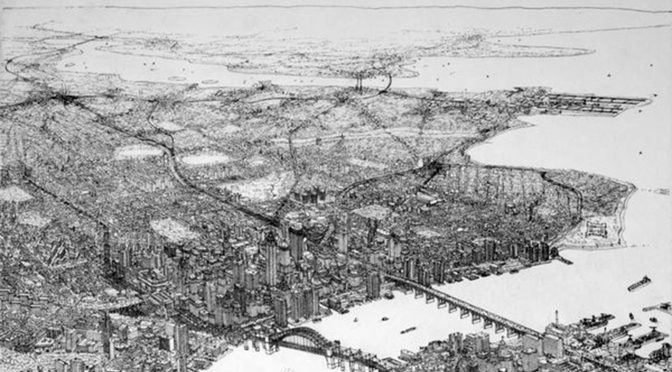
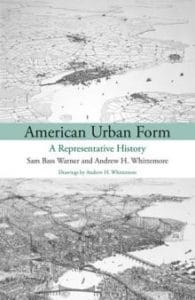
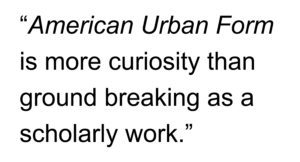 We have to believe this word choice is intentional. In this sense, American Urban Form comfortably sits within the prevailing planning paradigm of the post-war period in the United States (see M. Christine Boyer’s Dreaming the Rational City: The Myth of American City Planning for an excellent and detailed discussion on this topic). Unfortunately, it is also consistent with a recent, unfortunate trend in planning theory to claim to discuss one thing (physical form and space) but substantively reinforce prevailing thought (an a-spatial perspective of the city). Even when American Urban Form does discuss the physical fabric of ‘the City’, it tends to become trapped in discussing architectural styles.
We have to believe this word choice is intentional. In this sense, American Urban Form comfortably sits within the prevailing planning paradigm of the post-war period in the United States (see M. Christine Boyer’s Dreaming the Rational City: The Myth of American City Planning for an excellent and detailed discussion on this topic). Unfortunately, it is also consistent with a recent, unfortunate trend in planning theory to claim to discuss one thing (physical form and space) but substantively reinforce prevailing thought (an a-spatial perspective of the city). Even when American Urban Form does discuss the physical fabric of ‘the City’, it tends to become trapped in discussing architectural styles.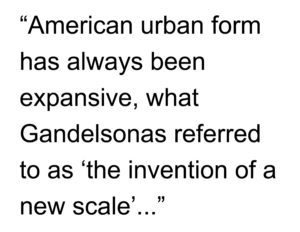 Namely, American urban form has always been expansive, what Gandelsonas referred to as “the invention of a new scale”, especially in comparison to European models of urbanism. If the authors had taken different cities as their subject (such as Chicago, St. Louis, and New Orleans), then a different (and, perhaps, more common) picture might have emerged in their narrative about the physical form of the American city.
Namely, American urban form has always been expansive, what Gandelsonas referred to as “the invention of a new scale”, especially in comparison to European models of urbanism. If the authors had taken different cities as their subject (such as Chicago, St. Louis, and New Orleans), then a different (and, perhaps, more common) picture might have emerged in their narrative about the physical form of the American city.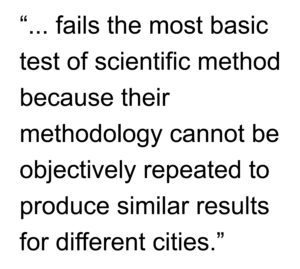 In itself, this is revealing since roughly half of the book is devoted to the first 200 years of ‘the City’ whereas the second half covers approximately the last 115 years. This is unfortunate since important aspects of early urban form are casually mentioned and their generative effects are not explored in detail. Instead, the narrative quickly returns to surer ground. i.e. a pseudo-history of political, social, and economic factors.
In itself, this is revealing since roughly half of the book is devoted to the first 200 years of ‘the City’ whereas the second half covers approximately the last 115 years. This is unfortunate since important aspects of early urban form are casually mentioned and their generative effects are not explored in detail. Instead, the narrative quickly returns to surer ground. i.e. a pseudo-history of political, social, and economic factors.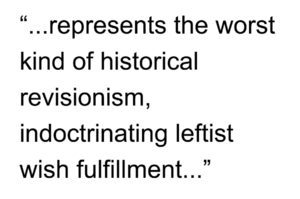 Much like Whittemore’s detailed and pretty bird’s eye views of ‘the City’ in the book (for the most part, vacant of meaning because they are a fiction, too; the one clear-cut exception is his wonderful aerial perspective of ‘dumbbell tenements’ on page 71), American Urban Form remains trapped in a single perspective on its subject. It either ignores, consigns to happenstance, or weaves an elaborate explanation for anything that might contradict or interrupt that perspective. Collectively, the result is a fanciful city of leftist, pseudo-Marxist fallacies. If you are already a member of the choir, you will like American Urban Form: A Representative History because you know the song and can sing along. If not, you will be better served by reading the history of a real city, examining in detail its historical plans and bird’s eye view drawings, and making your own conclusions.
Much like Whittemore’s detailed and pretty bird’s eye views of ‘the City’ in the book (for the most part, vacant of meaning because they are a fiction, too; the one clear-cut exception is his wonderful aerial perspective of ‘dumbbell tenements’ on page 71), American Urban Form remains trapped in a single perspective on its subject. It either ignores, consigns to happenstance, or weaves an elaborate explanation for anything that might contradict or interrupt that perspective. Collectively, the result is a fanciful city of leftist, pseudo-Marxist fallacies. If you are already a member of the choir, you will like American Urban Form: A Representative History because you know the song and can sing along. If not, you will be better served by reading the history of a real city, examining in detail its historical plans and bird’s eye view drawings, and making your own conclusions.
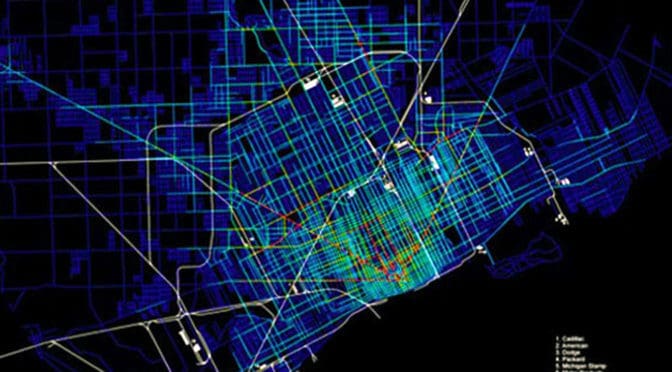
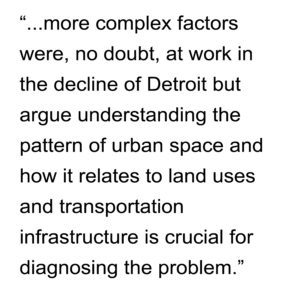 For example, they generally discuss what they describe as “Landscape Urbanism” without much detail. They are far too kind to reveal what, I suspect, is probably an outright disdain for this approach to serious urban problems. Landscape Urbanism only exists because it is politically expedient and offers policy makers/politicians the appearance of doing something (and feeds the financial coffers of consultants) when, in fact, it is usually a useless solution that avoids the real problem all together. What is really interesting about their historical analysis is where industrial land uses were not located; namely, along the riverfront at the edge of the Woodward plan. This suggests the seeds of Detroit’s urban decline might be traced back to the early 19th century. Large-scale industrial land uses may not have been allowed to develop along the riverfront of the Woodward plan. If the industrial land uses along Davison/Grand had come to be located along the riverfront instead of the northern periphery, Detroit may have been better positioned to manage its transition from an industrial to a post-industrial city, as other cities have accomplished to varying degrees of success.
For example, they generally discuss what they describe as “Landscape Urbanism” without much detail. They are far too kind to reveal what, I suspect, is probably an outright disdain for this approach to serious urban problems. Landscape Urbanism only exists because it is politically expedient and offers policy makers/politicians the appearance of doing something (and feeds the financial coffers of consultants) when, in fact, it is usually a useless solution that avoids the real problem all together. What is really interesting about their historical analysis is where industrial land uses were not located; namely, along the riverfront at the edge of the Woodward plan. This suggests the seeds of Detroit’s urban decline might be traced back to the early 19th century. Large-scale industrial land uses may not have been allowed to develop along the riverfront of the Woodward plan. If the industrial land uses along Davison/Grand had come to be located along the riverfront instead of the northern periphery, Detroit may have been better positioned to manage its transition from an industrial to a post-industrial city, as other cities have accomplished to varying degrees of success.